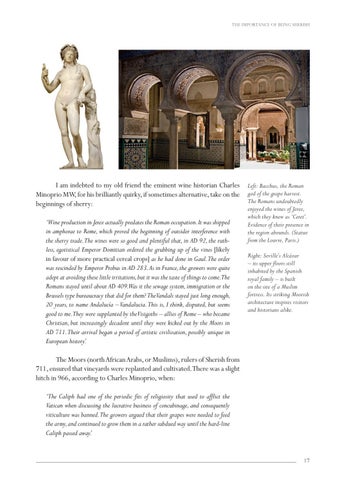The Importance of Being Sherish
T he I mportance
of
B eing
S h e r i sh
Map of Jerez by Francisco Zarzana in 1787, showing Jerez de la Frontera, Sanlúcar de Barrameda and Puerto de Santa Maria and their surrounding topography.
16
Sherry, rather like Ernest in Oscar Wilde’s brilliant trivial comedy for serious people, The Importance of being Earnest, started off life with a different name. In the play, Jack Worthing adopts the alias Ernest when he wishes to visit London incognito. He falls in love with Gwendolen, who explains to him that she absolutely wants to marry someone called Ernest, because the name sounds so solidly aristocratic. Confused and crestfallen, Jack has many adventures in this delightful but preposterous play, before he eventually discovers, via the classic ‘handbag’ scene, that he was indeed christened Ernest, so his marriage to Gwendolen can go ahead. Sherry’s home is in Andalucía, in southwest Spain. The original dwelling place was known as Xera by the Phoenicians, Ceret by the Romans and Sherish or Seris by the Moors, who from 711 dominated Spain for 500 years. When the Christians conquered the town in 1264, they christened it Xeres. Xeres gradually transformed into the name Jerez, which officially became Jerez de la Frontera in 1380. Jerez is pronounced ‘hereth’, with a guttural ‘h’ in Andalusian Spanish. This was a bit difficult for the English to say with any confidence. So Jerez became ‘sherry’. The Spaniards thus produce a world class wine, whose international name was essentially created by the English. Maybe it should revert to Sherish? Or would that suggest one had already had several glasses of this fine stuff? In comparison, I cannot imagine the French being so accommodating. Although it’s perhaps of note that the names for their ‘claret’ in the UK and ‘burgundy’ internationally are recognizably English.
I am indebted to my old friend the eminent wine historian Charles Minoprio MW, for his brilliantly quirky, if sometimes alternative, take on the beginnings of sherry: ‘Wine production in Jerez actually predates the Roman occupation. It was shipped in amphorae to Rome, which proved the beginning of outsider interference with the sherry trade.The wines were so good and plentiful that, in AD 92, the ruthless, egotistical Emperor Domitian ordered the grubbing up of the vines [likely in favour of more practical cereal crops] as he had done in Gaul.The order was rescinded by Emperor Probus in AD 283. As in France, the growers were quite adept at avoiding these little irritations, but it was the taste of things to come.The Romans stayed until about AD 409.Was it the sewage system, immigration or the Brussels type bureaucracy that did for them? TheVandals stayed just long enough, 20 years, to name Andalucía – Vandalucia. This is, I think, disputed, but seems good to me.They were supplanted by theVisigoths – allies of Rome – who became Christian, but increasingly decadent until they were kicked out by the Moors in AD 711.Their arrival began a period of artistic civilization, possibly unique in European history.’
Left: Bacchus, the Roman god of the grape harvest. The Romans undoubtedly enjoyed the wines of Jerez, which they knew as ‘Ceret’. Evidence of their presence in the region abounds. (Statue from the Louvre, Paris.) Right: Seville’s Alcázar – its upper floors still inhabited by the Spanish royal family – is built on the site of a Muslim fortress. Its striking Moorish architecture inspires visitors and historians alike.
The Moors (north African Arabs, or Muslims), rulers of Sherish from 711, ensured that vineyards were replanted and cultivated.There was a slight hitch in 966, according to Charles Minoprio, when: ‘The Caliph had one of the periodic fits of religiosity that used to afflict the Vatican when discussing the lucrative business of concubinage, and consequently viticulture was banned.The growers argued that their grapes were needed to feed the army, and continued to grow them in a rather subdued way until the hard-line Caliph passed away.’
17



